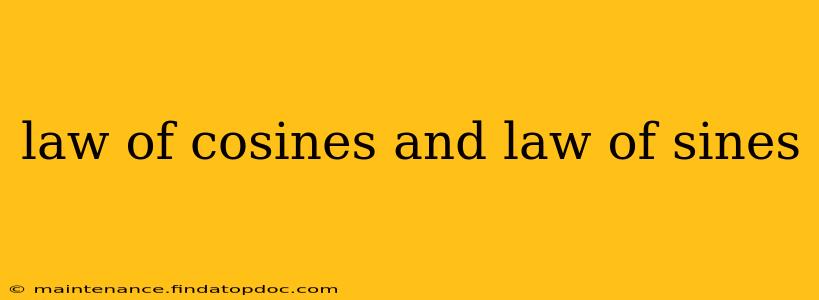Trigonometry often presents challenges when dealing with non-right-angled triangles. This is where the Law of Sines and the Law of Cosines become invaluable tools. These laws provide elegant solutions for determining unknown sides and angles in any triangle, regardless of its shape. This comprehensive guide will illuminate these fundamental trigonometric principles, providing clarity and practical examples.
What is the Law of Sines?
The Law of Sines states that the ratio of the length of a side of a triangle to the sine of its opposite angle is constant for all three sides of the triangle. Mathematically, this is expressed as:
a/sin A = b/sin B = c/sin C
Where:
- a, b, c are the lengths of the sides of the triangle.
- A, B, C are the angles opposite to sides a, b, and c respectively.
This law is particularly useful when you know:
- Two angles and one side (AAS or ASA): You can find the remaining angle and the other two sides.
- Two sides and an angle opposite one of them (SSA): This case can be ambiguous, meaning there might be two possible triangles that satisfy the given information (we'll explore this further below).
Example using the Law of Sines:
Let's say we have a triangle with angle A = 40°, angle B = 60°, and side a = 10 cm. Using the Law of Sines:
10/sin 40° = b/sin 60°
Solving for b:
b = (10 * sin 60°) / sin 40° ≈ 13.47 cm
We can then find angle C (since the angles in a triangle add up to 180°), and subsequently side c using the Law of Sines again.
What is the Law of Cosines?
The Law of Cosines provides a relationship between the lengths of the sides of a triangle and the cosine of one of its angles. It's particularly useful when you know:
- Three sides (SSS): You can find all three angles.
- Two sides and the angle between them (SAS): You can find the remaining side and the other two angles.
The Law of Cosines has three forms, one for each side:
- a² = b² + c² - 2bc * cos A
- b² = a² + c² - 2ac * cos B
- c² = a² + b² - 2ab * cos C
Where:
- a, b, c are the lengths of the sides of the triangle.
- A, B, C are the angles opposite to sides a, b, and c respectively.
Example using the Law of Cosines:
Consider a triangle with sides a = 8 cm, b = 10 cm, and c = 12 cm. To find angle A, we use the first form of the Law of Cosines:
8² = 10² + 12² - 2 * 10 * 12 * cos A
Solving for cos A:
cos A = (10² + 12² - 8²) / (2 * 10 * 12) ≈ 0.75
Therefore, A = cos⁻¹(0.75) ≈ 41.41°
Similarly, we can find angles B and C using the other two forms of the Law of Cosines.
The Ambiguous Case (SSA) in the Law of Sines
As mentioned earlier, the SSA case (two sides and an angle opposite one of them) can be ambiguous. This means there might be two possible triangles that fit the given information, one triangle, or no triangle at all. The determination depends on the relationship between the given side lengths and angle. Careful analysis and sketching are crucial in resolving the ambiguity.
When to Use Which Law?
- Use the Law of Sines when: You know two angles and a side (AAS or ASA), or two sides and an angle opposite one of them (SSA – be mindful of the ambiguous case).
- Use the Law of Cosines when: You know three sides (SSS), or two sides and the included angle (SAS).
Frequently Asked Questions
How do I determine which Law to use?
The best way to choose is to carefully analyze the information provided. If you have two angles and a side, use the Law of Sines. If you have three sides or two sides and the angle between them, use the Law of Cosines. The ambiguous case (SSA) requires special attention and careful analysis.
What if I only know one side and one angle?
With only one side and one angle, you cannot uniquely determine the remaining sides and angles of a triangle. You need at least three pieces of information (sides and/or angles) to solve for a triangle using either the Law of Sines or Cosines.
Can I use both laws together to solve a triangle?
Absolutely! Often, solving a triangle requires using both laws in succession. For instance, you might use the Law of Cosines to find one side, and then use the Law of Sines to find the remaining angles and sides.
Are there any limitations to the Law of Sines and Cosines?
While incredibly useful, these laws are only applicable to triangles. They cannot be directly applied to other shapes.
By understanding and applying the Law of Sines and the Law of Cosines, you unlock the ability to solve a wide range of triangle problems, expanding your capabilities in trigonometry and its diverse applications in fields ranging from surveying and navigation to engineering and physics.
